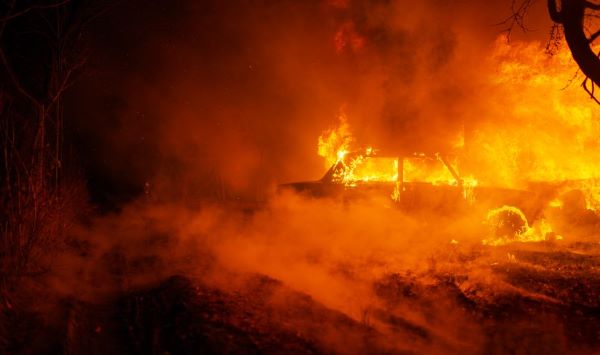
EV Myths #5 “Do EVs catch fire more than ICE cars?”

Have you heard this EV myth? “Those electric vehicles are an unacceptable fire hazard!”
I’m sure you have, since print media, TV, and social channels will trumpet every EV fire that happens…repeatedly. But what is the hazard reality in context to the currently accepted Internal Combustion Engine (ICE) status quo?
First off- can an EV catch fire? Well, since both EV and ICE vehicle tires, interior fittings (seats, panels, dash etc.) are all derived from petrochemicals they can burn if the flashpoint temperature can be reached. When these materials combust, the fumes are toxic and thus firefighters wear self-contained breathing apparatus to protect their airways when addressing ANY vehicle fire.
Since this is a common source of fuel for a fire between EV and ICE, we need to look at what sets the EV apart from its ICE predecessors, which is the nature of how they store the energy that drives the vehicle.
EVs store their energy in thousands of individual lithium ion (or increasingly, lithium iron phosphate) batteries cells collected into several modules. These battery modules are then encased in a protective pack attached flush to the underside of the vehicle pan. Under normal conditions their temperatures are moderated and controlled by the battery management system (BMS as covered in a previous article) and are essentially inert (nonreactive) to temperature swings.
However, if the protective battery casing can be pierced by metal, think high speed like a bullet or a very high-speed crash, then an electric short can be created. Or as discussed in a previous article, this can also be achieved by a factory defect. Regardless of event, this short will cause the damaged cells to start heating up to the point they can produce enough heat to start overheating adjacent cells at around 1800F/1000C.
As heat builds and spreads through the module enough heat can result in flammable materials starting to smoke. This may be the second indicator of a severe problem as, usually, the EV will have told you to pull over before the battery shuts down.
In a major accident, the EV battery will isolate itself from its high voltage connections to electric motors and HVAC, whilst simultaneously unlocking doors. Occupants have ample time to leave the vehicle before any actual fire can be seen, and the vehicle may even take hours to days before sufficient heat builds up to create a fire. That is an extreme and rare occurrence.
The total energy involved may be up to 100 kWh and, once fully involved, will burn very briskly in place without an explosion. While cooling the vehicle with water or smothering it with vehicle sized fire blankets are viable methods of attack, protecting nearby property is the best plan as the fire burns itself out in place.
Regardless, EV fire frequency is proportionally small (some sources say 5%) of the ICE fire rate as the circumstances required to get the battery hot enough for a fire are rare.
Secondly, ICE vehicles store their energy in the form of liquid petroleum stored in the rear half of the vehicle in a tank under the vehicle pan. The fuel tank has a fuel pump that then feeds the engine through fuel lines running forward to the engine bay. There the fuel is next to an engine which is using spark plugs and controlled explosions producing a great deal of heat.
These lines are not immune to degradation and loss of fuel next to that very hot lump of metal where the fuel’s flashpoint is a very low -49F/45C and ignites readily. The engine bay also features oil on the engine, either from spills or gasket leaks, that form a secondary source of fuel for a fire.
In an ICE vehicle accident, the fuel pump shuts off automatically leaving just the fuel in the lines and the main tank. If the accident is sufficiently violent, fuel/oil in the engine bay may be ignited forward of the aptly named “fire wall”. If the fuel tank is not punctured it will not be an issue until sufficient heat builds to cause an overpressure rupture, and potentially an explosion, with 50 litres of gasoline contain over 400 kWh of energy. This overpressure can then form streams of flaming liquid headed for waterway or drains- imagine that on a ferry!
In fact, US highway I95 was shut down in mid June as a tanker truck of flaming fuel had so compromised the concrete roadway above it to cause a collapse of tens of meters of four lane road. Repairs are slated to take months. The frequency of ICE car fires are such that they only make the news when traffic is impacted or there is heavy loss of life. In the US the rates reported by the National Fire Prevention Service are around 500, per day, hence why an ICE vehicle fire is no longer considered “news”. Most of these fires are a result of heat and or electrical spark igniting fuels essential to the ICE vehicle operation.
Considering that EVs have only been on the road in large numbers for the last 13 years or so, it is possible that more fires will occur because of age, which is also a significant factor in ICE vehicle fires. However, EVs do not have very low flashpoint fuels being pumped around the vehicle for a collision or spark to create a fire, and if the circumstances are such that the battery pack is compromised there is significantly more time for occupants to exit the vehicle or be removed before a serious fire can start. That is a huge reduction in fire hazard potential for any EV owner.
So, “No” EV batteries are not more of a fire hazard than the hazards of the ICE status quo we’ve spent the last 100 years accepting as part and parcel of transportation- EVs are much safer.
Thus, this fiery myth is BUSTED.


